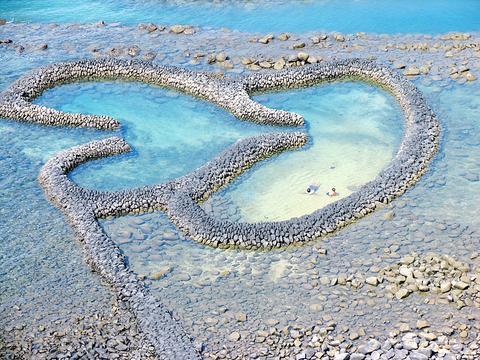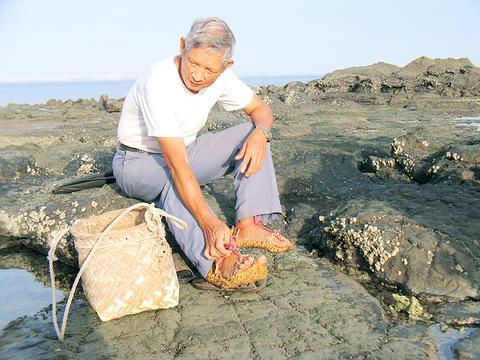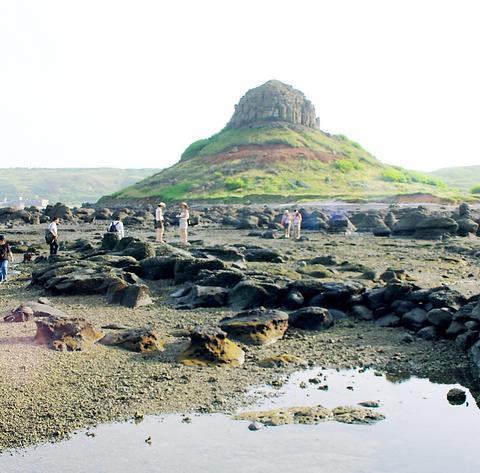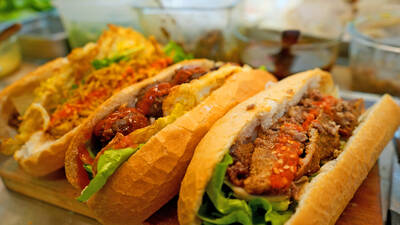Yang Chin-hua
Historians say stone weirs were first built in Penghu 700 years ago. The origins of most aren't known because they were public works; anyone in the community who could lift a rock and wanted to eat had incentive to help with construction. Because they eventually succumb to the tides, they have to be maintained.

PHOTOS: DAVID MOMPHARD, TAIPEI TIMES
But to call folks like Yang fishermen isn't entirely correct. Penghu's traditional lifestyle was equal time spent catching fish (often building a weir to catch more) and time spent coaxing crops out of infertile soil.

In farming, too, they built walls. On every island in the archipelago where crops have been cultivated, locals have stacked coral to protect their plants from the fierce winds that scour the archipelago in the winter months. Kilometers of meter-high walls crisscross the islands in a honeycomb pattern that is as pleasant to look at as it is practical.
But the stone weirs that trap fish have captured people's fancy, as well; none more than Twin Heart (

Yang's fish trap isn't the tourist trap that Twin Heart is. Mention Twin Heart, and he grimaces.
There are no young couples coming to photograph themselves in front of his fish trap -- there's no birds-eye vantage point from which to get it all in frame. And even if they could, no couple would want to be photographed in front of a fish trap called Cow's Heart (
Yang was out of luck in terms of materials to build his weir, too. Where Twin Heart sits beneath a cliff that has supplied an ample amount of basalt stones for its construction, Yang had to carry stones from the base of Turtle Mountain, a promontory of basalt rising 70m above sea level and hundreds of meters to the west. He used large pieces of coral in building it, as well, but said the heavier basalt didn't wash away as easily in the tide.
Yang started work on the project as a boy, helping his dad. A half-dozen able-bodied young locals who agreed to work for a share in the spoils joined them. The group piled stones by hand, one stone at a time, across an area the size of a football field. It took the better part of a decade.
How many fish does it catch in an average tide?
"Oh, maybe none. Not many," Yang said. "Fewer than it used to."
Though they've brought Yang his dinner all his life, the tides have slowly changed for Penghu. For the first half-century of Yang's life, his native Hsiyu was, in effect, more of an island than it is now. In the late 1970s, bridges connected it to Baisha and Matsu islands, making the three, in effect, one large island. About the same time, commercial air flights connected them to Taiwan proper. Then everyone left for paid work and a more modern lifestyle. Yang figures the folks that helped him stack his stone trap were among them.
"I haven't seen them here in a while," he said.

We lay transfixed under our blankets as the silhouettes of manta rays temporarily eclipsed the moon above us, and flickers of shadow at our feet revealed smaller fish darting in and out of the shelter of the sunken ship. Unwilling to close our eyes against this magnificent spectacle, we continued to watch, oohing and aahing, until the darkness and the exhaustion of the day’s events finally caught up with us and we fell into a deep slumber. Falling asleep under 1.5 million gallons of seawater in relative comfort was undoubtedly the highlight of the weekend, but the rest of the tour

Youngdoung Tenzin is living history of modern Tibet. The Chinese government on Dec. 22 last year sanctioned him along with 19 other Canadians who were associated with the Canada Tibet Committee and the Uighur Rights Advocacy Project. A former political chair of the Canadian Tibetan Association of Ontario and community outreach manager for the Canada Tibet Committee, he is now a lecturer and researcher in Environmental Chemistry at the University of Toronto. “I was born into a nomadic Tibetan family in Tibet,” he says. “I came to India in 1999, when I was 11. I even met [His Holiness] the 14th the Dalai

Following the rollercoaster ride of 2025, next year is already shaping up to be dramatic. The ongoing constitutional crises and the nine-in-one local elections are already dominating the landscape. The constitutional crises are the ones to lose sleep over. Though much business is still being conducted, crucial items such as next year’s budget, civil servant pensions and the proposed eight-year NT$1.25 trillion (approx US$40 billion) special defense budget are still being contested. There are, however, two glimmers of hope. One is that the legally contested move by five of the eight grand justices on the Constitutional Court’s ad hoc move

Stepping off the busy through-road at Yongan Market Station, lights flashing, horns honking, I turn down a small side street and into the warm embrace of my favorite hole-in-the-wall gem, the Hoi An Banh Mi shop (越南會安麵包), red flags and yellow lanterns waving outside. “Little sister, we were wondering where you’ve been, we haven’t seen you in ages!” the owners call out with a smile. It’s been seven days. The restaurant is run by Huang Jin-chuan (黃錦泉), who is married to a local, and her little sister Eva, who helps out on weekends, having also moved to New Taipei